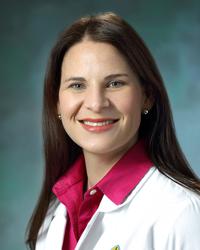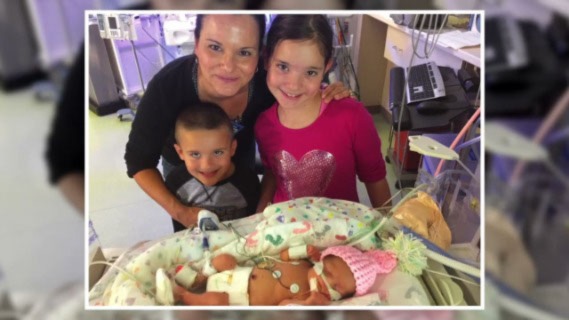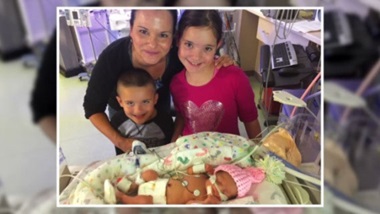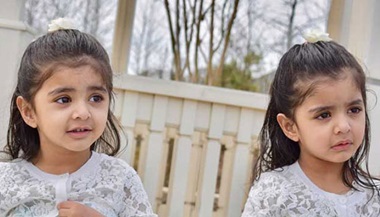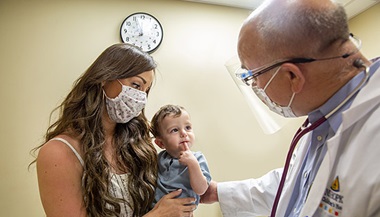Patient Story
Congenital Diaphragmatic Hernia (CDH): The Walshes’ Story
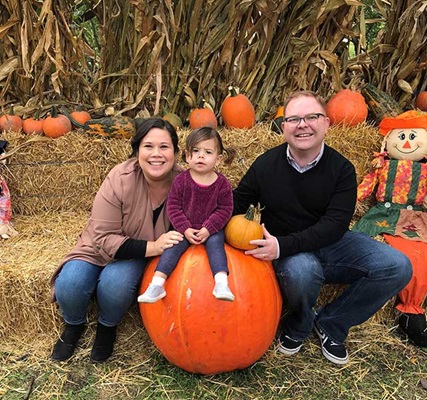
Patient Story Highlights
- Adrienne and Jim Walsh found out that their unborn baby, a girl they’d already planned to name Autumn, had a hernia in her diaphragm that threatened her survival.
- Fetal therapy experts at Johns Hopkins performed an in-utero procedure on Autumn and the neonatal team provided life-saving intensive care after the baby girl was born.
- The Walshes are grateful for the coordinated support they received for their daughter, who is now doing well.
When Adrienne Walsh and her husband Jim went for their 20-week sonogram of their first child, they learned they were going to have a girl.
But moments later, the doctor came in and Adrienne says she saw it in his face: There was a problem. The unborn baby, whom Jim and Adrienne wanted to call Autumn, was missing part of her diaphragm. The condition, called congenital diaphragmatic hernia, or CDH, is a prenatal disorder.
The diaphragm is a sheet of muscle under the lungs that enables breathing. A hole or missing place in the diaphragm can allow the abdominal organs to push upward (herniate) into the chest. The diagnosis of CDH is devastating: Fewer than 14% of fetuses with a CDH defect as severe as Autumn’s survive.
“Learning the diagnosis was probably the worst day of our lives,” Adrienne says.
An Innovative Procedure Offers Hope
When the Walshes went to Sibley Memorial Hospital (a Johns Hopkins member organization), the picture brightened: There was a slim margin of hope. That team referred the family to the Johns Hopkins Center for Fetal Therapy in Baltimore, where a study was being conducted by Ahmet Baschat, M.D., and Jena Miller, M.D. The team was testing an innovative in-utero balloon procedure to save babies with CDH.
They met with Miller in July 2017. “After seeing a series of specialists, we were learning more about CDH and finally beginning to feel hopeful,” says Adrienne.
“Although the course can be challenging with CDH, prenatal treatment may help more babies survive,” Miller says.
Baschat and Miller’s team fully evaluated the baby, and for a couple of nail-biting weeks, Jim and Adrienne waited to find out if they would qualify for participation in the study. They did.
The study required participants to live within a 30-minute drive of the hospital, so over the next few weeks, the Walshes uprooted their lives. They relocated to Baltimore and moved from rental housing to the Ronald McDonald House. They even found a local family to take in their Jack Russell terrier until they could get settled.
The team was hugely supportive.... The holistic approach and continuum of care is the reason Autumn defied the odds.
Adrienne Walsh
In August, Baschat performed the procedure, called fetoscopic tracheal occlusion, or FETO. The surgeon guided a catheter through Adrienne’s abdomen and uterus. Then, he inserted a tiny balloon into Autumn’s throat and inflated it so that it allowed the lungs to expand.
“While in the uterus, the placenta supplies the baby with oxygen and the lungs are not required,” Baschat explains. “But when it’s time for delivery, the air must be able to reach the lungs through the trachea (windpipe) and therefore, the balloon must be gone.”
He says. “After the procedure, the diaphragmatic hernia interfered with Autumn’s ability to swallow the amniotic fluid. As a result, the buildup of amniotic fluid distended the uterus, risking premature birth. Fortunately, the fetal therapy team was able to prevent this by draining the amniotic fluid and treatment of Adrienne’s uterine contractions. Six weeks after it was inserted, the balloon was deflated.”
Because of the increase in amniotic fluid, Adrienne was on partial bedrest. Baschat was doing everything possible to keep the baby from being born prematurely, giving Autumn more time to grow and strengthen. Jim dutifully pushed his wife around in a wheelchair.
Caution paid off: Autumn made it to 39 weeks, and in November was born by cesarean section performed by Baschat.
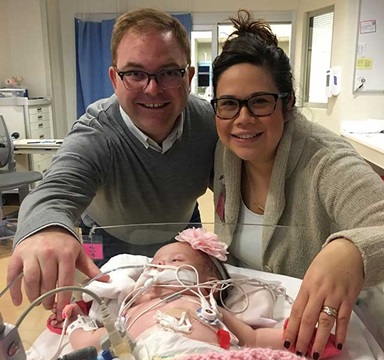
A Challenging Start Calls for Expert Intervention
Even though she made it to her full term, Autumn had a tough start in life, with heart failure at birth. In the pediatric intensive care unit, she had to have a form of life support called extracorporeal membrane oxygenation, or ECMO. ECMO provided life-giving oxygen to Autumn’s blood, since her heart and lungs were not functioning well enough. Johns Hopkins is one of the few hospitals that has this specialized capability.
While she was still on ECMO, Autumn underwent surgery to repair the hole in her diaphragm. Between November 2017 and the following January, there would be four more surgeries to support Autumn’s ability to breathe and absorb nutrients.
In all, Adrienne estimates that Autumn received care from about 50 people, and she’s grateful for each one. She says, “The team was hugely supportive, explaining what was going to happen, and reviewing Autumn’s progress at weekly meetings. The holistic approach and continuum of care is the reason Autumn defied the odds.”
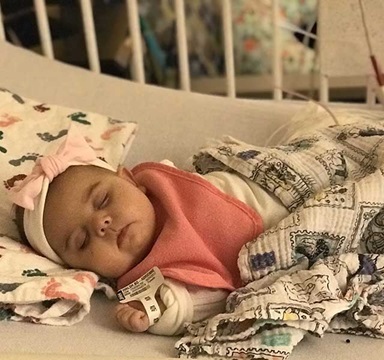
Advice for Parents of Babies with CDH
These days, Jim and Adrienne are happy to report that Autumn is doing well.
Jim has this advice for any parent learning that their unborn baby has CDH: “It’s important to get all the information you can. When something so devastating comes into your life, it seems so hopeless, like there are no options. You don’t know where to start.
“But for us, finding out what we could do about Autumn’s conditions really helped us. We had practitioners tell us that we should terminate the pregnancy, or assume that we wanted to. It wasn’t until we found out the full scope of CDH and what could be done that we realized it wasn’t a death sentence.”
He adds, “Even after the FETO surgery and the amazing care Autumn received, we still had a long road ahead. Once we brought her home, we had to work through feeding challenges and get continuing home nursing care for her. There were frequent trips to the hospital, including the emergency room. Autumn’s first birthday turned out not to be a destination, but another beginning.
“But now that Autumn is turning 2, her needs are pretty comparable to those of an average kid. We have a happy story to share as a result of working with Johns Hopkins and getting the full range of care.”
Adrienne agrees. “We were up against some hard decisions. Jim and I got to know other families whose babies had CDH, and who didn’t have the same outcome. I would tell any family facing this diagnosis to see Dr. Baschat at Johns Hopkins. Talk to a specialist, and do what’s right for your family,” she says.


